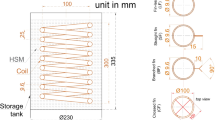Abstract
The temperature of a fuel-air mixture in the vicinity of a contact discontinuity formed in the process of exhaustion of a combustible gas (hydrogen, methane, and propane) into air after the shock-tube membrane breakdown is quantitatively evaluated. It is shown that conditions necessary for self-ignition of such a mixture are reached only when the shock wave reflected from the tube bottom passes through the mixture. An increase in the initial pressure of air in the tube exerts a dramatic adverse effect on the probability of self-ignition of the mixture. In addition, the calculation shows that favorable conditions for self-ignition of a methane- and propane-air mixtures, even after the secondary compression of the mixture behind the reflected-wave front, are observed only for a comparatively high pressure of the combustible gas prior to its exhaustion into the tube and simultaneously for a low initial pressure of air in the tube. The calculation results are in good agreement with available experimental data for a hydrogen-air mixture.
Similar content being viewed by others
References
A. A. Borisov, B. E. Gel’fand, and S. A. Tsyganov, “Gas-dynamic effects upon self-ignition of an atomized liquid fuel,”Dokl. Akad. Nauk SSSR,281, No. 2, 361–363 (1985).
P. K. Senachin, V. S. Babkin, and A. V. Borisenko, “Self-ignition ahead of the flame front in piston spark-ignition engines,”Fiz. Goreniya Vzryva,33, No. 6, 4–8 (1997).
Yu. A. Gostintsev, P. A. Gusev, Yu. A. Bokhan, et al., “Shock-wave ignition of a hydrogen-air mixture in a conical cavity,”Khim. Fiz.,16, No. 12, 69–81 (1997).
V. K. Baev, A. A. Buzukov, and B. P. Timoshenko, “Effect of secondary mixing as a means for improvement of inflammability of a fuel-air mixture in a diesel engine,” in:Physicochemical Problems of Burning of Hydrocarbon Fuels, Abstracts of All-Union Conf. (Moscow, May 20–22, 1998), TsIAM, Moscow (1998), pp. 60–61.
B. E. Gel’fand, S. V. Khomik, S. P. Medvedev, et al., “Self-ignition of homogeneous gaseous mixtures near nonflat surfaces,”Dokl. Ross. Akad. Nauk,359, No. 4, 490–494 (1998).
P. Wolanski and S. Wojcicki, “Investigation into the mechanism of the diffusion ignition of a combustible gas flowing into an oxidizing atmosphere,” in:Proc. 14th Symp. (Int.) on Combustion, The Combustion Inst., Pittsburgh (1973), pp. 1217–1223.
V. K. Baev, V. V. Shumskii, and M. I. Yaroslavtsev, “Self-ignition of a fuel gas escaping into an oxidizing medium,”Fiz. Goreniya Vzryva,19, No. 5, 73–80 (1983).
F. A. Bykovskii, V. B. Mitrofanov, and E. F. Vedernikov, “Self-ignition in gas-mixture flows,”Dokl. Ross. Akad. Nauk,358, No. 4, 487–489 (1998).
V. K. Baev, A. A. Buzukov, V. A. Konstantinovsky, et al., “Hydrogen jet combustion,” in:Hydrogen Energy Progress V: Proc. 5th World Hydrogen Conference (Toronto, Canada, July 15–20, 1984), Vol. 4, Pergamon Press, New York (1984), pp. 1641–1648.
V. K. Baev, A. A. Buzukov, B. P. Timoshenko, et al., “Self-ignition of hydrogen upon pulsed high-pressure injection into air,” in:Structure of Gas-Phase Flames, Proc. All-Union Workshop (Novosibirsk, July 12–15, 1983), Vol. 1, Inst. of Theor. and Appl. Mech., Sib. Div., USSR Acad. of Sci., Novosibirsk (1984), pp. 179–188.
V. K. Baev, A. A. Buzukov, and V. V. Shumskii, “Unsteady structure of a hydrogen jet and the conditions of shock-induced ignition upon its injection into air at high pressure,” in:Advances in Experimental and Computation of Detonation, Book of Abstr. Intn. Colloquium (St. Petersburg, Russia, September 14–17, 1998), ENAS Publishers, Moscow (1998), pp. 108.
V. V. Khodot,Sudden Outbursts of Coal and Gas [in Russian], Gosgortexizdat, Moscow (1961).
K. Feucht, G. Holzel, and W. Hurich, “Perspectives of mobile hydrogen application,” in:Hydrogen Energy Progress VII: Proc. of 7th World Hydrogen Conference (Moscow, USSR, September 25–29, 1988), Vol. 3, Pergamon Press, New York (1988), pp. 1963–1974.
A. P. Kudryash, V. P. Marakhovskii, and A. A. Kaidalov, “Working process in a gas-diesel engine,” in:Alternative Fuels in Internal Combustion Engines: Abstracts of All-Union Conf. (Kirov, May 24–27, 1988), Kirov. Sel’skokhoz. Inst., Kirov (1988), p. 75.
E. S. Shchetinkov,Physics of Gas Combustion [in Russian], Nauka, Moscow (1965).
B. D. Henshell, “On some aspects of the use of shock tubes in aerodynamic research,” ARC Reports and Memoranda No. 3044, London (1957).
N. F. Dubovkin,Handbook on Hydrocarbon Fuels and Their Combustion Products [in Russian], Énergoizdat, Moscow (1962).
B. E. Gel’fand, O. E. Popov, S. P. Medvedev, et al., “Distinctive features of self-ignition of hydrogen air mixtures under high pressure,”Dokl. Ross. Akad. Nauk,330, No. 4, 457–459 (1993).
V. T. Grin’, A. N. Kraiko, and L. G. Miller, “Decay of a shock wave at a perforated baffle,”Prikl. Mekh. Tekh. Fiz.,22, No. 3, 95–103 (1981).
G. I. Nikolaev, “Experimental study of formation of a shock wave reflected from the wall with an orifice,”Izv. Akad. Nauk SSSR, Mekh. Zhidk. Gaza, No. 2, 176–181 (1974).
V. N. Odentsev, “Sudden outburst of coal and gas — destruction of natural coal as a methane solution in a solid substance,”Fiz. Tekh. Probl. Razrab. Polezn. Iskop., No. 6, 18–28 (1997).
S. V. Kuznetsov and B. N. Okonchuk, “Motion of coal-gas mixture at sudden outbursts,”Fiz. Tekh. Probl. Razrab. Polezn. Iskop., No. 2, 94–100 (1974).
A. A. Buzukov, “Fast-compression facility for studying the process in the internal-combustion engine,” in:Dynamics of Systems, Mechanisms, and Machines: Abstracts of Int. Conf. (Omsk, Russia, November 21–24, 1995), Book 1, Omsk. Gos. Univ., Omsk (1995), pp. 70–72.
Author information
Authors and Affiliations
Additional information
Translated fromFizika Goreniya i Vzryva, Vol. 36, No. 3, pp. 3–10, May–June, 2000.
This work was supported by the Russian Foundation for Fundamental Research (Grant No. 97-01-00506).
Rights and permissions
About this article
Cite this article
Baev, V.K., Buzukov, A.A. & Shumskii, V.V. Conditions of self-ignition upon pulsed high-pressure injection of combustible gases into a bounded space. Combust Explos Shock Waves 36, 283–290 (2000). https://doi.org/10.1007/BF02699378
Received:
Revised:
Issue Date:
DOI: https://doi.org/10.1007/BF02699378




